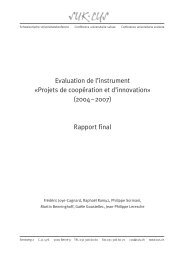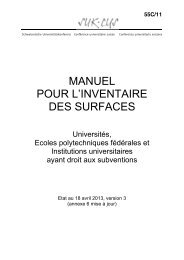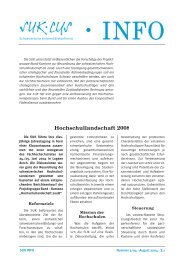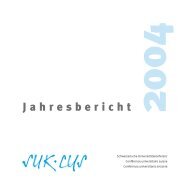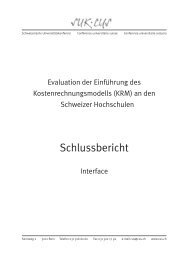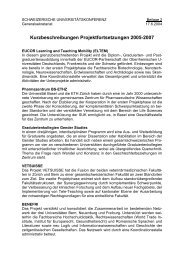Evaluation of the Swiss Virtual Campus - Schweizerische ...
Evaluation of the Swiss Virtual Campus - Schweizerische ...
Evaluation of the Swiss Virtual Campus - Schweizerische ...
Create successful ePaper yourself
Turn your PDF publications into a flip-book with our unique Google optimized e-Paper software.
SVC Final <strong>Evaluation</strong>. Background Report Lepori and Probst<br />
involved pr<strong>of</strong>essors). The creation <strong>of</strong> institutional centres <strong>of</strong> competence in <strong>the</strong> higher education<br />
institutions was also meant to answer to <strong>the</strong>se issues which emerged in <strong>the</strong> impulsephase.<br />
2.2 The Consolidation Programme: mission and outline<br />
While <strong>the</strong> overall goals <strong>of</strong> <strong>the</strong> programme were not modified, <strong>the</strong> second phase (consolidation<br />
phase) took into account <strong>the</strong>se experiences and, hence, entailed a significant change in <strong>the</strong><br />
implementation strategy, taking also into account <strong>the</strong> goal stated in <strong>the</strong> multiyear planning <strong>of</strong><br />
<strong>Swiss</strong> universities <strong>of</strong> <strong>the</strong> Rector’s Conference (CRUS) to have at least 10% <strong>of</strong> <strong>the</strong> courses<br />
supported by new educational technologies.<br />
The main innovation has been <strong>the</strong> goal <strong>of</strong> developing elearning competence centres (CCSP) in<br />
each <strong>Swiss</strong> HEI, in a number <strong>of</strong> cases by streng<strong>the</strong>ning already existing structures. These<br />
centres should dispose <strong>of</strong> pr<strong>of</strong>essional teams with <strong>the</strong> technological and pedagogical<br />
competences needed to develop elearning courses, with two main benefits: ensuring long-term<br />
accumulation <strong>of</strong> competences and experiences, also beyond <strong>the</strong> end <strong>of</strong> <strong>the</strong> individual projects,<br />
as well as a reduction <strong>of</strong> <strong>the</strong> development costs through scale effects and transfer <strong>of</strong><br />
experiences from project to project. Moreover, <strong>the</strong>se centres should permit a better integration<br />
<strong>of</strong> <strong>the</strong> SVC projects in <strong>the</strong> overall university strategy, overcoming a weakness <strong>of</strong> <strong>the</strong> impulse<br />
phase projects, which were largely located at <strong>the</strong> level <strong>of</strong> individual chairs.<br />
To streng<strong>the</strong>n <strong>the</strong>se centres, <strong>the</strong> SVC devised three types <strong>of</strong> mechanisms:<br />
• A basic funding for each centre linked to <strong>the</strong> number <strong>of</strong> students and teachers. For<br />
universities, <strong>the</strong> CCSP received a fixed allocation <strong>of</strong> 100,000 per university and per year<br />
plus a variable allocation depending on <strong>the</strong> number <strong>of</strong> students and teachers. For UAS, a<br />
similar mechanism was put in place through OPET funding.<br />
• A stronger involvement <strong>of</strong> <strong>the</strong> centres in <strong>the</strong> SVC projects: both for <strong>the</strong> maintenance <strong>of</strong> <strong>the</strong><br />
existing projects and <strong>of</strong> <strong>the</strong> new projects <strong>the</strong> involvement <strong>of</strong> <strong>the</strong> CCSP was required; for<br />
new projects, <strong>the</strong> CCSP received a fixed amount <strong>of</strong> money (overhead) to take care <strong>of</strong> <strong>the</strong><br />
production <strong>of</strong> <strong>the</strong> elearning modules. This was particularly emphasised for <strong>the</strong> last series <strong>of</strong><br />
projects, where <strong>the</strong> project proposal was jointly prepared and co-signed by <strong>the</strong> CCSP.<br />
• Finally, a regular review <strong>of</strong> <strong>the</strong> CCSP functioning and activities by <strong>the</strong> SVC steering<br />
committee, meant largely as a coaching for <strong>the</strong> development <strong>of</strong> <strong>the</strong> centres.<br />
Moreover, additional funding was provided to already existing projects to help <strong>the</strong>ir maintenance<br />
and integration in <strong>the</strong> participating universities (on <strong>the</strong> average 60,000 CHF per project and<br />
year; no additional funding for UAS projects) which could be requested through applications<br />
evaluated by <strong>the</strong> SVC steering committee; maintenance was later also available for <strong>the</strong> new<br />
projects <strong>of</strong> <strong>the</strong> consolidation phase (3 rd project series). The decision on maintenance was based<br />
on criteria related to <strong>the</strong> project network, <strong>the</strong> reduction <strong>of</strong> in-class hours, <strong>the</strong> number <strong>of</strong> users<br />
and <strong>the</strong> recognition in <strong>the</strong> curricula <strong>of</strong> <strong>the</strong> developed modules. The main aim <strong>of</strong> <strong>the</strong> maintenance<br />
was to finance updating <strong>of</strong> materials and to give more time and resources to integrate <strong>the</strong>m in<br />
<strong>the</strong> curricula.<br />
Two calls for proposals for new projects were launched in 2004 and 2005. While <strong>the</strong> general<br />
principles were <strong>the</strong> same as in <strong>the</strong> impulse phase, <strong>the</strong> new calls entailed a number <strong>of</strong> significant<br />
changes:<br />
• <strong>the</strong> blended learning approach was <strong>of</strong>ficially endorsed (instead <strong>of</strong> developing completely online<br />
modules);<br />
• <strong>the</strong> CCSP <strong>of</strong> <strong>the</strong> leading house was charged with <strong>the</strong> production <strong>of</strong> <strong>the</strong> elearning modules in<br />
collaboration with <strong>the</strong> project leader and had to be integrated from <strong>the</strong> beginning in <strong>the</strong><br />
project;<br />
• <strong>the</strong> amount <strong>of</strong> federal funding <strong>of</strong> <strong>the</strong> projects was significantly reduced. Each project<br />
received a basic allocation <strong>of</strong> 300,000 CHF, <strong>of</strong> which 100,000 as a fixed overhead for <strong>the</strong><br />
CCSP (for <strong>the</strong> 4 th call <strong>the</strong> amounts were reduced to 150,000 CHF, respectively 50,000 CHF;<br />
with a supplement <strong>of</strong> 50,000 CHF for some projects). UAS projects received lower funding.<br />
Finally, a number <strong>of</strong> support measures and mandates were foreseen, concerning technical<br />
support – including <strong>the</strong> provision <strong>of</strong> national learning management systems – as well as<br />
pedagogy and organization <strong>of</strong> elearning.<br />
17





